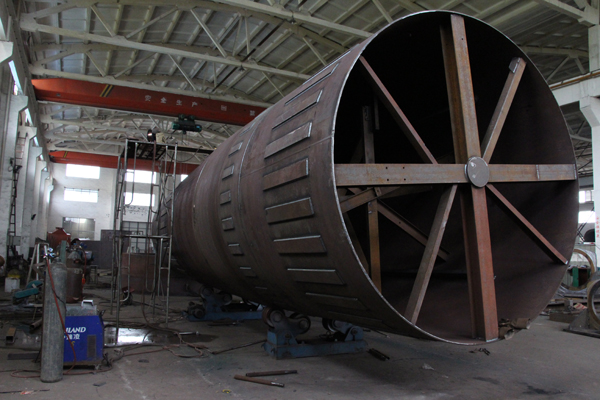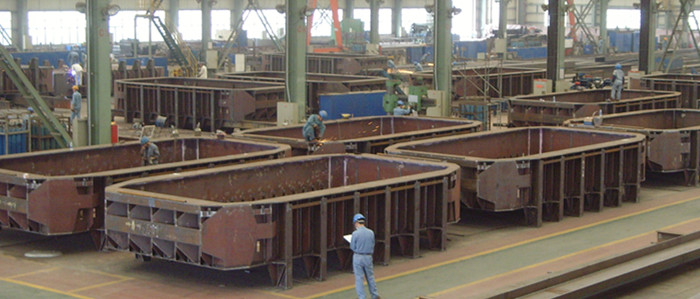1.Preface
Welded structures refer to the structural parts made of metal materials processed by welding. Its quality is directly related to the safety of production. In the manufacturing process of components, welding and materials determine the quality of the structure,Therefore, great attention must be paid to materials and welding joints, and the requirements of relevant regulations must be met to ensure the quality of welded structural parts.
2. Manufacturing process of welded steel structures
2.1 Process analysis, welding test, welding process qualification, process planning, equipment installation and other technical preparation process;
2.2 Material re-inspection, confirmation; material marking and marking transplant, materials preparation and inspection;
2.3 Welding groove preparation, group pairs, spot welding fixing and inspection.
2.4 Preparation before welding, including drying of welding materials, cleaning of welding parts, etc.
2.5 Welding shall be carried out according to the specified welding procedure requirements (including preheating according to the regulations).
2.6 Welding inspection, including visual inspection and non-destructive inspection, etc.
2.7 The unqualified weld must be repaired, and the deformation should be corrected when the deformation exceeds the prescribed requirement.
2.8 The weld is processed after welding according to the technological requirements.
2.9 The appearance of the treatment and anti-corrosion treatment.
3. Influence of welding technology and environment on welding quality
3.1. Materials used no re-examination; Wrong use and mixed use materials due to no clear marking, which all could cause that the material used is unqualified, it will bury hidden dangers to the welding quality problems behind.
3.2 The size of the groove is unqualified, and if the opening size of the groove is too small and it will result in poor welding or improper fusion, and if it is too big, it will cause waste of welding materials and lead to steel structure deformation.
3.3 Unqualified in group pairs, uneven clearance, staggered edge problems, which all eighther can increase the difficulty of welding or cause difficulties in using automatic welding machine.
3.4 Tag welding seam is too short, too thin or too big distance between each others will cause the welded parts to break off, which will affect the welding process, and may also make the cracks hidden under the formal weld, resulting in potential quality hazards;
3.5 If the material is not done drying and rust removing according to the requirements, means cleaning work is not done well before welding, the defects such as porosity and slag inclusion will be caused.
3.6 Weather environment, including wind, snow, rain and other environments will also increase the difficulty of welding, without taking appropriate measures to improve and protect the welding condition, it will cause have a great impact to welding quality.
4. General method for quality control of welded structure manufacturing
4.1 Strict quality assurance system is the premise for quality control of welding components manufacturing.
If a manufacturer wants to control the quality of the products well, it must establish a quality management system that matches the quality requirements of the products, this is the ensure that the quality of products can meet the standards.
4.2 Scientific and rigorous technical and process measures are the basis for quality control.
Technical and process measures generally include the following:
- 4.2.1 Scientific process analysis is the basis for making correct process routes and procedures.
A.The material of the main structure, the weldability of the material, and whether the welding procedure qualification of the material has been done before.
B. The specification of the main structure material (thickness and length), analyze the manufacturability of welded joint type designed. What welding methods should be adopted to meet the requirements of welds?
C. Understand the size, length and layout of the welding seams, and analyze the influence of each welding seam on the welding deformation. Roughly calculate the deformation of each welding seam and the effect that these deformations have on the whole component deformation.
D. Analyze the comprehensive influence of welding residual stress on steel structural parts. If necessary, the influence of welding stress on welding crack should be judged by calculation, and the ability of welding seam to bear fatigue load when the workload is superimposed, which lays a foundation for formulating measures to reduce or eliminate residual stress.
4.3 On the basis of process analysis, determine the purpose, requirement, specimen type, experiment and test method of the specific items of welding process test and implement preliminary process procedure, and test and confirm the feasibility of the initial procedure.
4.4 To compile the detailed construction process procedures through the process analysis and the process test results. Procedures include materials preparation, assembly, welding procedures, main parts of the process chart, welding sequence, preheating and post-heat treatment procedures and inspection procedures.
While compiling the technological rules, we should also do a good job in the design, manufacture and matching of tooling according to the technological regulations. Including the preliminary training of construction personnel, the focus is on the welder's technical training, equipment maintenance, measurement instrument verification, etc., to truly ensure that the technical preparation work is truly carried out.
5. Quality Control
Do quality control in manufacturing process. To do well in quality control of manufacturing process, we should do the following work.
5.1 Make clear in clarification and disclosure of technical issues, and make clear requirements for product quality
5.2 Carrying out the working instruction according to the “three principles”. That is, unqualified and unmarked raw materials shall not be put into use; No welding should be carried out before parts inspection; No welding shall be carried out if required welding condition is not ready according to procedure.
5.3 The parts that need outsourcing, sub-suppliers should be evaluated and audited. The products and accessories provided by sub-suppliers should be strictly inspected according to the standards and should not be used if they can not meet the standards.
5.4 Check the execution of the process at any time,once the problem is found, it must be solved immediately.
-5.4.1 Check whether the process regulations are strictly implemented, and whether the finished process and product quality conform to the requirements.
-5.4.2 Analyze the quality of the defective products and take corresponding measures to solve them.
5.5 All records in the process should be complete, and a complete manufacturing archive should be set up for archiving and preservation.

6. Strict management and policy support
6.1 Strict management is a essential condition to ensure the implementation of all technical measures and obtain good quality products.
- 6.1.1 Technical process and quality management should be carried out in accordance with the above requirements.
- 6.1.2 The production management is based on the technical regulations and should make reasonable and scientific arrangements for the construction period.
- 6.1.3 According to the special requirement of welding, we should strengthen the management of welding materials, welder marking, product number and welding environment.
6.2. Use matching economic means to improve the sense of responsibility of staff, and do everything possible to ensure the enthusiasm of product quality.
7. Measures to prevent deformation of welded structural parts
7.1Select reasonable welding heat input
Generally speaking, the greater the heat input, the greater the deformation of the welded steel structure. The welding method with small heating area and concentrated energy can be used. Multilayer welding is usually used instead of single layer welding. Intermittent welding, backward welding and skip welding are used instead of continuous welding.
On the premise of ensuring the welding quality, the welding heat input should be as small as possible, which can reduce the heat input of welding parts and minimize the welding deformation.
7.2 Assembly and welding sequence of welded structure will also cause structural deformation. Therefore, it is very important to take reasonable welding sequence to control welding distortion.
- 7.2.1 Assembly and welding principles
In the actual process of production, welding methods should be selected according to the specific conditions of welded parts and related technical requirements. Simple central symmetric components should be welded symmetrically. For simple components with asymmetrical along the neutral axis, the side with fewer welds is usually welded first, and then the side with more welds is welded. When splicing large area sheet metal, short staggered seams in the middle should be welded first, in the order from inside to outside, and finally long straight outside seams should be welded.
- 7.2.2 Symmetrical welding
If the weld seam of the welded structure is axisymmetrical in the center, the deformation of the component will occur if the welding sequence is not reasonable. The welding sequence of each welding line is different. Therefore, with the increase of the number of welding seams, the rigidity of structure will be strengthened constantly, the first weld is easy to deform the structure parts, and the later weld has little effect on the deformation of the structure parts. Therefore, in order to prevent deformation caused by welding, symmetrical welding is used to offset welding deformation. For example, two welders can do welding symmetrically according to the proper welding sequence.
- 7.2.3 Asymmetric welding
The steel structures with asymmetric welding seams are very common. In the welding process, the side with fewer welds should be welded first, and then the side with more welds should be welded. The specific method should be decided according to the size and direction of deformation.
- 7.2.4 Adopting different welding sequence
For long and continuous welding in the steel structural parts, continuous straight welding will cause greater deformation. If conditions permit, the continuous welding can be changed into section welding, and the welding direction can be adjusted.
- 7.2.5 Reverse deformation method
This method is widely used, that is, according to the law of welding deformation, the weldment is purposefully pre-made into a deformation in the opposite direction of welding deformation,and the prefabricated deformation should be similar to that of the welding deformation. So that to offset welding deformation and prevent the welding deformation.


